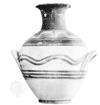- Proto-Geometric style
-
Visual art style of ancient Greece that signaled the reawakening of technical proficiency and conscious creative spirit after the collapse of the Minoan and Mycenaean civilizations, around the 12th century BC.The vocabulary of the style was limited to circles, arcs, triangles, and wavy lines, all derived from Minoan-Mycenaean representations of aquatic and plant life. On pottery, these design elements were carefully placed in horizontal bands, mainly at a vase's shoulder or belly. Its lower portion was usually either left plain or painted in a solid glossy black pigment inherited from Bronze Age artists.
 Proto-Geometric amphora from Athens, early 10th century BC; in the Kerameikos Museum, Athens.Hirmer Fotoarchiv, Munich
Proto-Geometric amphora from Athens, early 10th century BC; in the Kerameikos Museum, Athens.Hirmer Fotoarchiv, Munich* * *
▪ Greek artvisual art style of ancient Greece that signaled the reawakening of technical proficiency and conscious creative spirit, especially in pottery making. With the collapse of the Minoan-Mycenaean civilization about the 12th century BC, the arts sustained by the palace bureaucracies disappeared, together with literacy. Invasions and wars kept a once-flourishing civilization practically in caves, the only creative production being some rough, shoddily executed pottery. About 1050 BC, judging from the improvement in pottery, life seems to have become more settled, enabling pottery makers to become artists again.The vocabulary of the Proto-Geometric style is limited to circles, arcs, triangles, and wavy lines, all derived from Minoan-Mycenaean representations of aquatic and plant life. The design elements are conscientiously rendered, with compasses and multiple brushes, and are carefully placed in horizontal bands on significant parts of the vase, mainly at the shoulder or belly. The lower portion of the vase, which was now better made and well proportioned, was usually either left plain or painted in a solid glossy black pigment inherited from Bronze Age artists. Other than vases, surviving artworks include only some simple, bronze, safety-pin-like clasps called fibulae and some primitive clay figures showing clear Minoan influence; but the evidence of the vases shows a new art developing out of a ruined civilization, a new ability to discipline hand and eye that evolved into the Geometric style.* * *
Universalium. 2010.
